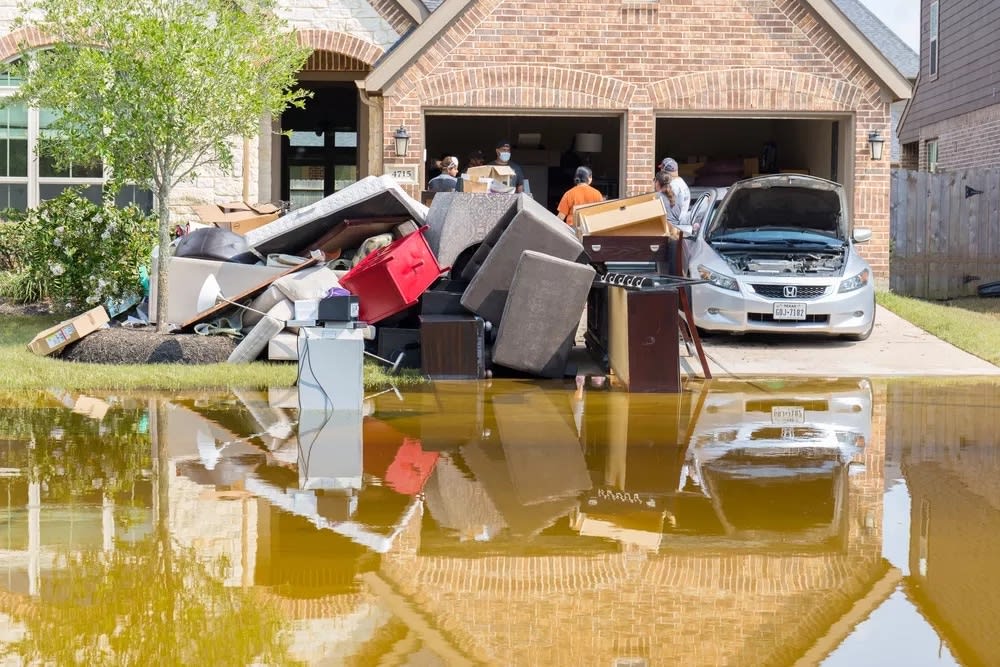After the recent heavy rains and flash floods caused significant damage along the North West, many property owners may find themselves dealing with damp, soggy properties and furnishings.
If you’ve experienced flooding in your property, either by heavy rain, a burst water pipe or damage caused by a leak, you’ll want to sort it fast. Water in a property can cause a multitude of issues including:
- Rust
- Mould
- Damp
- Dry rot
- Mud and silt
- Bacterial infections due to contaminated water
- Damage to electrics
- Damage to plaster
- Wood warp
- Structural damage
The first thing to understand about drying out a property is that it takes time. Even a small leak can cause problems, as the building will need to be allowed to ventilate naturally. Using a natural technique such as evaporation may be slow, but in most cases, it will be better for your property and cause less damage in the long run.
To help you, we’ve put together an easy step by step guide to help you understand what you need to do to minimise the damage and help you with the cleanup process.
Safety First
Before attempting to conduct any work on your property or assessing the damage, the most important thing to remember is to put the safety of you and everyone entering the building first. Assume all electrical wires are live. Do not assume the property’s gas, water and electricity have been switched off. If you can smell unpleasant odours, consider that they may be:
- Gas leak
- Sewage
- Contaminated water
- Chemicals (particularly if a storage facility such a cellar or basement has been flooded)
If you have to enter the property, make sure that all utilities have been switched off at the mains supply and that you are wearing suitable safety equipment – remembering to cover your mouth, eyes and hands.
Use antibacterial disinfectants to clean yourself after entering the property, to reduce the risk of contracting any waterborne bacterial infections. It is entirely possible to catch illnesses such as salmonella and e-coli from floodwater.
Take Photos
Before you start any cleaning up work on your property, be sure to take photographs of the water damage and to keep any damaged items such as furniture and carpets for inspection. This will help your insurance claim to be processed more efficiently and will also help to document your claim, so you get the best possible outcome.
Start at the Top
Begin your property-drying efforts in the attic. Starting in the attic helps you to avoid any damage to first floor ceilings, and kick-starts the drying process. Here’s a simple checklist to use:
- Check insulation for damp, and dispose of if wet.
- Remove wet or water damaged items (but keep them for inspection by loss adjusters).
- Open any windows and vents to allow air circulation.
Next, start on any upper-floor rooms and work through all rooms in the property.
- Check for damaged or loose plaster.
- Check for bulging ceilings – these may be holding trapped water. Poke small holes in these and lay buckets out to catch any water to avoid catastrophic damage.
- Water within a wall cavity can be removed by removing the skirting board and (using a cordless drill) drilling holes several inches above the floor.
- Remove any wet insulation via the skirting board removal.
- Remove wet carpets, vinyl flooring and underlay.
Once you’ve tackled the worst of the water retention, it’s time to start drying out your property. Open all the windows to allow fresh air to circulate. This is the best way to dry out a flooded house and helps to reduce the likelihood of warping and cracking in the wooden floorboards and plaster in the walls and ceilings.
Another more practical solution is to use dehumidifiers, which Action Insurance Repair can source and install for you. As flood specialists, we understand that you want to get your property dried out as soon as possible, and dehumidifiers certainly speed up the process.
Sorting out a Flooded Cellar or Basement Rooms
Although the first thing you might want to do is pump any excess water out, flooded cellars and basement rooms require patience and care.
At Action Insurance Repair, as well as being quality-assured contractors we have links with specialist contractors and can source the equipment needed for this delicate job.
If the surrounding ground is saturated with water, by quickly ridding the water from your property’s basement space could result in creating uneven pressure – meaning you could cause cracks, or even structural damage. Because of this, we really recommend getting professional help as your attempts might end up costing you more down the line.

